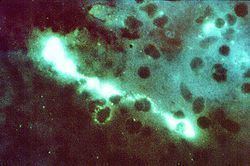Scientific name Chlamydophila Phylum Chlamydiae | Rank Genus | |
 | ||
Lower classifications Chlamydophila psittaci, Chlamydophila felis, Chlamydophila pneumoniae, Chlamydophila pecorum | ||
Chlamydophila pneumoniae
Chlamydophila is a bacterial genus belonging to the family Chlamydiaceae, order Chlamydiales, class/phylum Chlamydiae.
Contents
Chlamydophila pneumoniae
Taxonomy
Chlamydophila was recognized in 1999, with six species in Chlamydophila and three in the original genus, Chlamydia. All Chlamydiae are anaerobic bacteria with a biphasic developmental lifecycle that depends on obligately intracellular growth in eukaryotic host cells.
Prior to 1999, criteria for chlamydial species were not exclusive. For example, at that time genus Chlamydia = family Chlamydiaceae; C. psittaci were distinguished from C. trachomatis by sulfadiazine resistance, although not all C. psittaci were resistant; C. pneumoniae was classified by its appearance under electron microscopy (EM) and its ability to infect humans, although the EM appearance was found to differ from one research group to the next, and all of these species infected humans.
The systematic taxonomy established for Chlamydiae in 1999 uses up-to-date, prevailing criteria for bacterial classification, including DNA-DNA reassociation, 16S and 23S ribosomal RNA gene similarity, sequence similarity clustering of protein coding genes, and genome size. Supporting criteria such as antigen detection, glycogen staining, host association, and EM morphology are also employed, depending on applicability and availability. In 1999, many Chlamydia strains were reorganized into the genus Chlamydophila.
Comparative genomic analyses have identified large numbers of signature proteins that are uniquely present in species from the genera Chlamydia and Chlamydophila, supporting the distinctness of these genera. This view has been challenged by a more recent whole genome analysis leading to a proposal to "reunite the Chlamydiaceae into a single genus, Chlamydia". To date, this nomenclature controversy has not been resolved.
Chlamydophila differentiation
The mean DNA-DNA reassociation similarity distinguishing Chlamydophila from Chlamydia is 10.1% (95% confidence interval = 6.8 through 13.5), an accepted value for genus separation.
Divergence of Chlamydophila from Chlamydia is indicated by sequence similarity clustering of protein coding and ribosomal RNA genes. The 16S ribosomal RNA gene sequences of Chlamydophila and Chlamydia are close to 95% identical. However, 95% is not a cutoff for separating Chlamydiaceae genera but is a guideline for establishing new genera in chlamydial families. The full-length 23S rRNA genes of Chlamydophila and Chlamydia species are less than 95% identical.
Species
Distinctions such as EM morphology, antibiotic resistance, and extrachromosomal plasmid are typically species-specific characteristics.
Species in Chlamydophila include:
